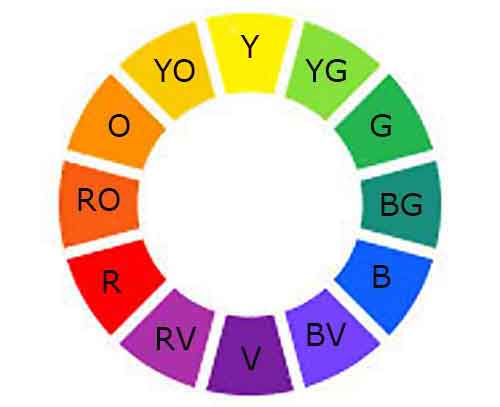| Back to Back Issues Page |
 |
|
Painting Art Ezine: Use color bias to mix colors March 17, 2023 |
, welcome to the Ezine! A Tip on Mixing Paint ColorsOur paintings are composed of color. We can't be a successful artist without learning how to mix colors. Even if we buy a whole array of different colors, they probably will need some adjustments. That's where mixing colors comes in. Learning to mix colors takes practice, but a little knowledge speeds up the learning curve.
What is Color Bias?Color bias is when a color contains some of the color next to it on the color wheel. The color leans one way or the other.Many of our paints are not an entirely pure color. The best we can do is use colors that contain only one color pigment. Single pigment colors mixed with other single pigment colors produce clean, clear colors. When we mix a color containing 2 or more pigments with another color, we are actually mixing three colors together. The 3 mixed colors tend to be muted and dull compared to mixing only 2 pigments together. Even a single pigment color, may lean left or right from its place on the color wheel. That’s color bias.
Warm and Cool ColorsA suggested double primary palette contains a warm and cool version of each of the primary colors.This palette speeds up the mixing process. Here are single pigment colors for a double primary palette. • Yellow: Lemon Yellow, cool / Cadmium Yellow, warm • Red: Cadmium Red Medium, warm / Permanent Rose, cool • Blue: Ultramarine Blue, warm / Phthalo Blue, cool Let’s look at the color wheel to refresh our memory.
Use Color Bias for Mixing ColorsLet’s suppose we want to mix an orange. Yellow and red make orange. Mixing any colors between primary yellow and primary red would make variations of orange.Could we use red-violet and yellow to mix oranges. No, why not? Even though red-violet has a lot of red, it also contains blue. It has a blue bias. Blue is the compliment of orange, so we would get some muddy colors resembling orange. What if we mixed red with yellow-green? Would this give us orange? We would run into a similar problem because yellow-green (Lemon Yellow) has a blue bias. We would actually be mixing 3 colors together. We wouldn’t get a good, clean orange because blue is included in the mixture. When want to mix a violet which reds and blues should we use? Looking at the 2 reds we see the red-orange (Cadmium Red Medium) has a yellow bias. Mixing it with blue would be mixing 3 colors. That would create a muddy violet. Primary red is the best choice. Which blue should we use? The blue-violet (Ultramarine Blue) has a red bias. Mixing it with the primary red gives us some lovely violets.
Let’s mix some greens. Primary yellow and primary blue give us the pure, vivid greens. Phthalo Blue and Lemon Yellow give us the cool spring greens. Phthalo Blue and Cadmium Yellow Light make warmer greens. We can get different tints of green by adding white. Add a dark to create different shades of green. Or add a compliment to mute the greens. If we mix any yellow with a blue-violet (Ultramarine Blue) we more muted greens. The best way to mix is to have a larger amount of yellow and add just a little bit of the blue. It doesn’t take much blue to transform the yellows.
What If We Don’t Want to Mix All the Colors?Here are the names of some of the colors available for purchase.Many manufactures use their own brand name on the colors. Whether we are shopping for oils, acrylics or watercolors, we need to look on the label or the manufacturer’s website for the actual color pigments. • Primary Yellow - Cadmium Yellow Light or pale, Hansa Yellow Light, Azo Yellow, Bismuth Yellow • Yellow-orange - Cadmium Orange, Permanent Orange • Orange - Coral Orange, Cadmium Scarlet, Vermilion, Perinone Orange, Pyrrole Orange • Red-orange - Cadmium Red Medium, Pyrrole Red Medium • Primary Red - Permanent Rose, Quinacridone Rose, Quinacridone Crimson • Red-violet - Magenta, Quinacridone Violet • Violet - Ultramarine Violet, Dioxazine Violet • Blue-violet - Ultramarine Blue, Indanthrene Blue • Primary Blue - Phthalocyanine Blue • Blue-green - Turquoise Green, Blue Green, Peacock Blue • Green - Viridian, Permanent Green Deep, Phthalocyanine Green • Yellow-green - Permanent Green Light
We Learn by DoingPractice mixing colors.Get your paint colors out and practice mixing when you are not actually doing a painting. Just concentrate on the colors, what they look like and how they react. You may want to put some of the mixed colors on a sheet of paper and save them for future reference. Noting what colors made the mixture. Have Fun!
Thank YouThank you all who have subscribed to the Great Gifts Ezine.Do to circumstances, this is the last issue of the ezine. From time to time I will do similar articles on the God Gifts Blog page. So be sure and subscribe to the blog. Many blessings to you all and keep painting!
|
| Back to Back Issues Page |
